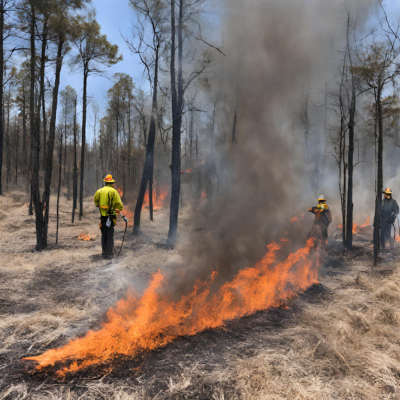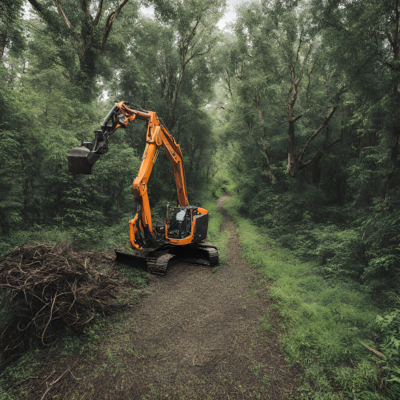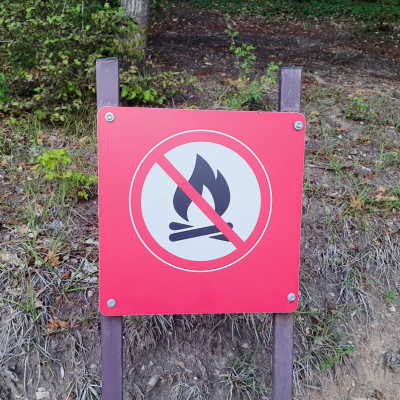Averting the Flames: How to Prevent Bushfires in Australia
- Ben Jones
- Jul 4, 2023
- 6 min read
Updated: Mar 11, 2024
In this article:

Introduction
Australia's remarkable natural beauty is accompanied by a diverse climate that can give rise to devastating bushfires, making the question of how to stop bushfires from wreaking havoc a crucial topic for the nation.
These fires occur throughout the year, engulfing millions of acres of land every season. During the notorious 2019-2020 bushfire season, an estimated 24 million hectares (59 million acres) - an area the size of the UK - were ravaged, highlighting the need for effective prevention methods.
Australia's vast landmass, characterized by its hot and dry climate, provides the perfect conditions for bushfires to thrive. The country has experienced increasingly severe bushfires in recent years, with the catastrophic 2019-2020 fire season, also known as the "Black Summer," serving as a stark example.
Climate change exacerbates this issue, with rising temperatures and erratic weather patterns fuelling more severe fire seasons. The average bushfire season now lasts 130 days — almost a month longer than 40 years ago.

Causes and Impacts of Australian Bushfires
Why is bushfire prevention so important? Primarily because their impacts are so wide-ranging and severe, affecting the environment, human health, wildlife, and economic prospects.
What Causes Bushfires in Australia?
The causes of bushfires are not dissimilar to causes of wildfires around the world. Humans are predominantly to blame, whether intentionally or otherwise.
Bushfires can be ignited by various natural and human factors. Lightning strikes and extreme heat are common natural causes, while human-induced factors such as arson and accidental ignitions (such as from burning debris) contribute significantly to these disasters. With the population growth and increasing development, the risk of human-caused fires rises, emphasizing the need for responsible actions to prevent such incidents.
The Devastating Impact of Bushfires on Local Communities
The scale and severity of recent bushfires have left many individuals financially and physically affected, with 57% of Australians exposed to the resulting smoke from the 2019/2020 bushfires. Indigenous communities have been disproportionately affected.
In addition to the impact on human life and damage to properties, bushfires can also have long-term repercussions on local economies, as businesses – particularly those dependent on agriculture and tourism – suffer from the aftermath, with 17% of companies closing their doors as a result of bushfires in 2019/2020 bushfires.
Infrastructure such as transport, telecommunications, and power supply systems also get severely affected, hindering recovery efforts and causing further distress to the already vulnerable communities.
The Toll on Australian Wildlife and Ecosystems
Australia's unique and diverse wildlife has been one of the worst-affected aspects of these catastrophic bushfires. As per recent estimates, the 2019-2020 bushfires alone resulted in the death or displacement of almost three billion animals, many of which were native species like koalas and kangaroos.
These disastrous events have led to either significant loss of habitat or even local extinctions, threatening the balance of ecosystems and the survival of some species. Moreover, bushfires often have cascading effects on the environment. They can lead to further environmental disasters such as erosion, soil degradation, and water pollution, posing grave threats to the health of ecosystems and humans alike.

The Importance of Bushfire Prevention
While eliminating the risk of bushfires entirely is impossible, investing in bushfire prevention is crucial to minimize their occurrence and severity.
Understanding Bushfire Risk
Australia's climate, vegetation and weather make bushfires a particularly acute and pressing problem. Its hot, dry summers, especially coupled with drought conditions, create ideal conditions for bushfires to ignite and spread. Eucalyptus forests and dense bushland release flammable oils, making them particularly fire-prone. Furthermore, strong winds can rapidly fan flames and carry embers long distances, causing spot fires.
Cost-effectiveness of Proactive Measures
Though bushfire prevention requires investment, the costs are considerably lower than those associated with managing and recovering from major bushfires. Analysts put the total cost of the 2019-2020 bushfires at around $100 billion Australian Dollars.
In addition to the direct costs of fighting fires and providing immediate relief, there are long-term consequences such as losing tourism revenue, rebuilding infrastructure, mental health support, and ecosystem restoration efforts. These recovery efforts can take years and place a significant financial strain on communities and governments.
Investing in bushfire prevention measures can significantly reduce costs associated with bushfire management and recovery. The modest investment required for prevention can save billions of dollars in the long run, making it a practical choice as well as a financially responsible one.
Strategies for Bushfire Mitigation: Legislation, Education, and Collaboration
While bushfires are not new, the increasing intensity and frequency have become a cause for concern, prompting the government and organizations to step up their prevention and awareness-raising efforts.
Legislation and Policy-making
One of the key strategies to prevent bushfires is the implementation and enforcement of legislation and policies. The Australian Government established the National Bushfire Recovery Agency as a response to Black Summer and to work with communities and territory governments to rebuild local communities.
Australian state and local governments have designed various regulations and guidelines, such as land management, use of firefighting equipment, and clearance of fire hazards from properties to minimize the risk of bushfires. These policies include controlled burns, creating and maintaining firebreaks, and specified periods restricting outdoor fires.
Awareness and Education
Raising awareness and educating communities is a significant part of bushfire prevention efforts in Australia. Fire agencies, such as the Country Fire Authority (CFA) and Rural Fire Service (RFS), conduct public education campaigns that inform people about the bushfire risk, what to do during a fire, and how to prepare and implement bushfire survival plans, often working closely with schools to educate. These initiatives have led to safer behavior and compliance with fire prevention regulations.
Cross-agency Collaboration
Effective bushfire prevention efforts require close collaboration between sectors such as fire agencies, emergency services, land management authorities, and research organizations.
For example, the Australian Government collaborates with the CSIRO (Commonwealth Scientific and Industrial Research Organisation) to study bushfire behavior and develop innovative fire management techniques. This collaboration extends to the international level, as Australia shares its knowledge and expertise with other countries facing similar challenges.
Bushfire Prevention: Practical Steps and Preparedness
Bushfire preparedness efforts primarily focus on reducing the likelihood of fires starting and limiting their spread. Controlled burning, vegetation clearing, and maintaining defensible space are among the key prevention measures. These efforts significantly reduce the number and impact of fires when they do occur.
Prescribed Burning
Prescribed burning (also called controlled burning or hazard reduction burning) is a crucial element of bushfire prevention and is a large part of the NPWS fire management program to protect biodiversity and manage vegetation.
It involves intentionally igniting small, low-intensity fires in a controlled manner to remove undergrowth, dried grass and excess vegetation that otherwise could fuel more significant bushfires. This lowers the intensity of future fires and makes them easier to manage and extinguish.
Vegetation Clearing
Clearing vegetation near buildings and roads is another essential preventive measure. This creates a buffer zone, reducing the likelihood of a bushfire spreading to populated areas. It also ensures that emergency services can access the affected areas more easily.
Defensible Space
Related to vegetation clearing, defensible space is a strategically cleared and maintained area around your home that slows or stops the spread of wildfire, giving firefighters a better chance to defend your property.
Preventing Accidental Ignitions
The vast majority of bushfires are human-induced, with the most common causes being discarded cigarettes, unattended campfires or barbecues, and machinery malfunctions. Heeding caution when choosing to light a campfire, or when using power tools, can go a long way to preventing bushfire ignitions in the first place.
Embracing Innovation: The Role of Technology in Bushfire Management
In the fight against bushfires, technology is our powerful ally. From cutting-edge satellites to advanced fire prediction models, groundbreaking innovations are transforming the way we detect, monitor, and combat these devastating events.
Early Detection and Warning Systems
Early detection of bushfires is crucial to prevent ignitions turning into raging wildfires. Governments, municipalities and fire agencies employ various technologies to detect fires, such as satellites, weather-monitoring systems, and aircraft.
Australia has developed a three-level bushfire alert system but has faced criticism that it’s not regionally consistent and has become outdated since its inception in 2004.
Many utility companies, insurance companies, and local governments have adopted innovative technology like Dryad's network of solar-powered bushfire sensors to detect fires early in their smouldering phase. Prevention is often better than cure and, in this case, could save public bodies millions or even billions in the process.

Conclusion
In the face of the escalating bushfire threat, Australia's journey towards resilience and safety is more crucial than ever. This narrative not only illuminates the stark realities and challenges posed by bushfires but also underscores the importance of comprehensive prevention strategies and innovative solutions.
As we navigate through an era marked by climate change and environmental uncertainties, our collective commitment to bushfire prevention, education, and technological advancements emerges as our strongest defense.
The path forward requires a synergy of efforts—from legislation and policy-making to community engagement and technological innovation. By embracing a culture of preparedness, fostering cross-agency collaboration, and investing in early detection systems, we can significantly mitigate the risks and impacts of bushfires.





